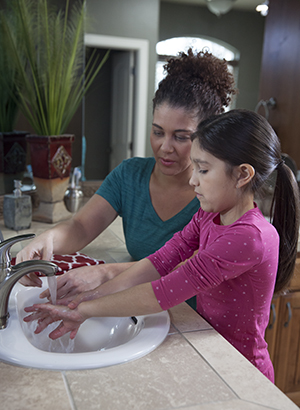Reducing the Risk for Middle Ear Infections
Most children have had at least 1 middle ear infection by age 2. Treatment may depend on whether the problem is acute or chronic. It also depends on how often it comes back and how long it lasts.
Reducing risk factors
 |
| Good handwashing can help your child prevent ear infections. |
Some behaviors or things raise your child’s risk for an ear infection. Reducing these risks can be helpful at any point in treatment. Here are some tips:
-
Make sure your child knows how to wash their hands the right way. This includes washing hands often with soap and clean, running water for at least 20 seconds. Your child can use hand sanitizer when needed.
-
If your child goes to group daycare, they have a greater risk of getting colds or the flu. These may then lead to an ear infection. Help prevent these illnesses by teaching your child to wash their hands often and staying up-to-date on their flu vaccine.
-
Keep your child away from crowds during cold and flu season.
-
Tell your child to stay away from secondhand smoke and other irritants. Don’t let anyone smoke in your home or your car.
-
If your child has nasal allergies, do your best to control dust, mold, mildew, and pet hair and dander in the house.
-
If food allergies are a problem, identify the food that triggers the reaction. Help your child stay away from it.
-
Make sure your child is up-to-date on vaccines.
In your child's first year of life, you can also reduce the risk of ear infections by:
Watching and waiting
If your child is diagnosed with an ear infection, the healthcare provider may prescribe antibiotics right away or suggest a period of “watchful waiting.” This means not filling the prescription right away. Instead, you will first try medicines to ease your child’s symptoms, such as those for pain or a fever. Ask the provider which over-the-counter medicines are safe to give your child. You’ll then wait to see if your child gets better.
If your child doesn't get better in a few days or develops new symptoms, such as a fever or vomiting, antibiotics will often be started. Your child's provider may prescribe antibiotics right away. Or they may advise a period of watchful waiting. This will depend on your child's age and risk factors.
Online Medical Reviewer:
Ashutosh Kacker MD
Online Medical Reviewer:
Marianne Fraser MSN RN
Online Medical Reviewer:
Tara Novick BSN MSN
Date Last Reviewed:
9/1/2022
© 2000-2024 The StayWell Company, LLC. All rights reserved. This information is not intended as a substitute for professional medical care. Always follow your healthcare professional's instructions.